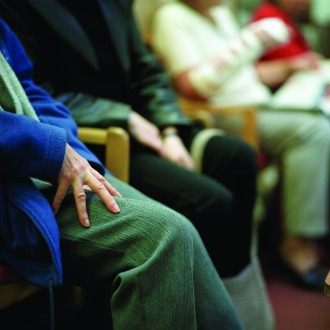Less than half of patients are offered on-the-day appointments, according to new figures.
Data released by the Government has shown that 42% of patients obtain a GP appointment booked on the same day, while 5% have to wait for a month to see their GP.
It follows the news that there were 213,000 fewer same-day appointments this year compared to last, and a 15% increase in month-long waits for GP appointments.
Labour MP Paul Farrelly asked health secretary Matt Hancock what recent assessment he has made of the ‘adequacy of the number of GPs in the UK per capita, time it takes to obtain an appointment and amount of time GPs spend with patients’.
In response, health minister Ms Kennedy provided figures showing how long on average patients wait between the moment they book an appointment and get one.
Ms Kennedy said: ‘The data on GP appointments are from a new data collection and are still experimental therefore the data and collection method are still being refined and improved. Whilst these early datasets published by NHS Digital do not yet represent a comprehensive picture, they are an important key step in understanding pressures on primary care.
‘The average GP consultation time with a patient is determined by each practice, depending on the needs and demands of their patient list. The amount of time GPs spend with their patients is not collected or held centrally.’
BMA GP Committee executive member Dr Farah Jameel said: ‘These figures highlight how hard GPs are working across the country to meet demand despite a challenging environment, delivering a high proportion of appointments on the day of booking and the majority within a week.
‘While it’s impossible to know for sure, those waiting longer may have booked ahead or been part of routine bookable availability for chronic disease management, and this is acceptable, appropriate and often necessary.’
Under the new five-year GP contract, NHS England has committed to fund 22,000 practice staff, including pharmacists and physiotherapists, as part of a bid to help GPs manage their workload.
Ms Jameel stressed the importance of having the ‘promised’ workforce to address issues around GP waiting times.
She said: ‘GPs are doing an incredible job, providing millions more appointments each year with hundreds fewer doctors, managing the challenges that come with an ageing, growing population with complex health needs.
‘However, GPs do remain concerned that too many patients have to wait longer than they’d prefer, and we need the promised expansion of the workforce to be realised to start to address that.
‘With the additional 20,000 practice-based staff agreed in this year’s GP contract, we hope that we will see both the workload burden on doctors reduce, while providing easier and more timely access for patients to reach the appropriate healthcare professional.’
NHS Digital data released this week shows that the average the average number of registered patients per GP in England has risen to 2,087 – an extra 56 people compared with last year.
GPs have warned the increasing numbers of patients is ‘concerning’ and putting patient safety under threat.
But Ms Kennedy said there is no guidance on the number of patients GPs should see.
She said: ‘There is no recommendation for how many patients a GP should have as the demand each patient places on their GP is different and can be affected by various factors, including rurality and patient demographics. When considering the ratio of GPs to patients it is important to consider GPs as part of the wider multidisciplinary team. Getting the skills mix right in general practice is critical in addressing workload pressures as well as in delivering appropriate patient care.
‘The Government has committed to growing the workforce by 5,000 additional full time equivalent doctors in English general practice as soon as possible. NHS England and Health Education England are working together with the profession to increase the GP workforce. This includes measures to boost recruitment, address the reasons why GPs are leaving the profession and encourage GPs to return to practice.’
NHS England’s latest annual patient survey showed the number of patients who find it easy to get through to their GP practice continues to fall over the years.
Pulse July survey
Take our July 2025 survey to potentially win £1.000 worth of tokens












